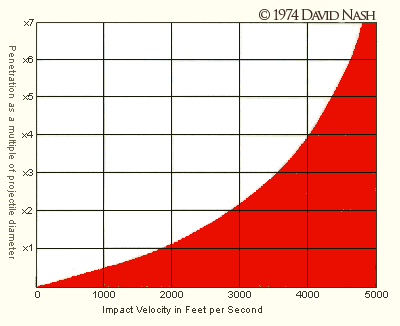The penetration of AP (Armour Piercing) Shot is determined primarily by its weight and velocity at the moment of impact. Other factors can influence it’s velocity (such as wind, pressure and atmospherics), or its ability to “bite” into the armour (e.g. ballistically curved surfaces, such as the T-34 turret or Porsche King Tiger Mantlet, or different shaped projectile heads, can cause rounds to ricochet). Finally the angle of the target’s armour, along with the firer’s angle of shot can affect the relative thickness of armour presented to the round that will need to be penetrated.
However the first issue is to determine the shot’s velocity at the moment of impact, which will be directly determined by range (and weather conditions, but that’s another issue again). Although all weapons have slightly different characteristics, the following formula can be safely used to determine “with reasonable accuracy” the theoretical velocity of a weapon’s shot at any give range. For the examples on this page we shall be using the British 2pdr Ordnance Quick-Fire – the standard tank and anti-tank weapon of the Commonwealth forces from 1939 until Mid-1942, and in use on Armoured Cars and Light Tanks until the end of the war – which has the following characteristics:
Calibre: 1.58″ (40mm)
Shot Weight: 2 lbs 6 oz (1.08 kg)
Muzzle Velocity: 2,616 fps (785 m/s)
The velocity of the projectile can be determined using the following formula:
F = 250/C
Where F is the percentage loss in velocity over 250 yards, from a known velocity, and C is the calibre of the weapon in millimetres.
For example our 2pdr OQF, firing AP (or Solid Shot if you prefer) has a loss of muzzle velocity of 250/40, or 6.25%. So our 2pdr Shot leaves the muzzle at 2,616 fps, at 250 yards it has lost 163.5 fps (i.e. 6.25%) giving it a muzzle velocity of 2,452.5 fps. Once the shot reaches 500 yards it will have a muzzle velocity of 2,299.2 fps (2,452.5 fps less 6.25%), and so on…
Now that we have determined our shot’s muzzle velocity at a specific point, we need to determine how much armour it is capable of penetrating. The table below is a guide to determining this. Taking our example above we see that the 2pdr OQF at 2,452 fps (i.e. 250 yards) will penetrate about 1.7 times it’s diameter (that is 68mm), and at 2,299 fps (i.e. 500 yards) will penetrate about 1.4 times it’s diameter (56mm).

It is important to note that the figure obtained is for penetration of armour at 0º, and that this is theoretical, and takes no account of the effects of weather on muzzle velocity, shot characteristics (shot material such as steel or tungsten, and shot shape), the angle of shot and/or target armour, or the effects of “undermatching” or “overmatching” (i.e. where the shot’s calibre is significantly lesser or greater than the thickness of armour it is trying to penetrate).
SOURCE: Wargames – by David Nash (1974)